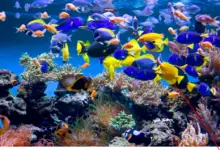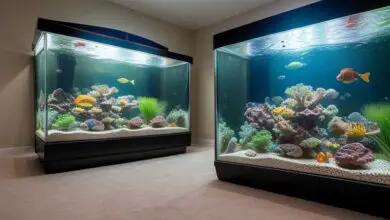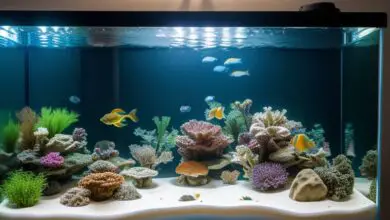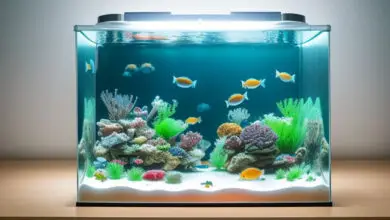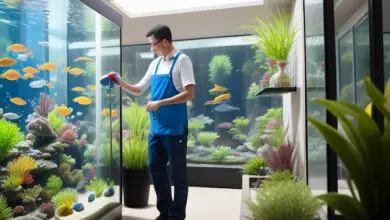17 Eco-Friendly Tips for Every Fish Tank Owner

Keeping home aquariums is a beloved hobby worldwide. But with great enjoyment comes the responsibility to steward aquatic life and resources wisely. There are many small changes we can implement that make the pastime more sustainable for our tanks inhabitants as well as the planet.
In this blog, we’ll explore over 17 eco-friendly aquarium practices you can adopt for healthier, happier fish communities that also conserve energy, water and materials through natural methods. Everything from LED lighting upgrades to harvesting live foods is covered in simple beginner steps!
Why Keep Aquariums Sustainably?
First, what do we mean by “keeping an aquarium sustainably”? Sustainable aquarium keeping refers to implementing hobby practices, equipment choices and maintenance routines focused on:
- Protecting fish, invertebrate and plant health through natural methods
- Conserving environmental resources like energy and water long term
- Avoiding pollution stemming from harsh chemicals and plastic disposables
There are overlapping benefits across all three spheres – life in our home tanks, environmental ecosystems downstream and our own wallets over time! It’s win-win all around.
For Aquarium Life: Sustainability provides better water quality, nutrition and habitat safety for all tank dependents compared to harsh chemicalized methods. Natural parameters keep inhabitants healthier long term.
For the Planet: Every eco-upgrade implemented conserves precious resources like clean water, fossil fuels for energy generation and landfill space by reducing waste accumulating from the hobby.
For Owners: While sustainable equipment upgrades might cost more upfront occasionally, their long term durability coupled with lower energy/water bills earn back savings over time through years of enjoyable service. Plus accomplishing self-sufficiency goals feels great!
Now let’s get to the good stuff – actionable tips for greening up your home aquarium practices starting today! We’ll work through sustainable water, feeding, gear, cleaning and aqua scaping suggestions…
Sustainable Water Quality Practices
Since aquarium inhabitants live immersed inside closed water systems it’s vital to maintain clean parameters constantly. Here are some eco-friendly methods perfect for the conscientious aquarist:
Establish Nitrogen Cycles Naturally – Cultivate a bustling nitrobacteria colony using fishless cycling instead of dumping ammonia chemicals to speed the process along artificially. This foundational ecosystem powers your tank for years.
Spot Clean Algae – MANUALLY remove as much hair, spot and green dust algae as possible during routine tank maintenance instead of dosing potent algaecides which disrupt balance and threaten wildlife.
Test Water Sans Strips – Forgo test STRIPS containing nasty heavy metals and dyes. Digital photo meters provide very accurate ammonia and nitrate tracking for years with zero plastic waste compared to hundreds of disposed test strips.
Embrace Botanical Boosters – Leaves, cones and pods from sustainable botanical sources like catappa almond leaves or bee pollen naturally enhance tank nutrition, water quality and fish vitality across species.
Try Natural Clarifiers – All-natural water POLISHERS like pearl powder suspensions, barley straw liquid or chitosan clear cloudy tanks by clumping microparticles so filters grab them easily. No nasty chemical flocculants involved!
Optimizing sustainable water quality establishes a healthy base benefiting all tank life for years on end. Now let’s talk eco-friendly fish feeds…
Sustainable Aquarium Fish Feeding Tips
Varied nutrition sustains aquarium fish best by providing balanced whole food proteins, oils, vitamins and carbs for proper growth and coloration. Here are some earth-friendly feeding tips:
Offer Sustainable Base Diets – Feed HIGH quality pellet and flake foods featuring reputable ingredient sources like whole Antarctic krill, algae and calamari meals with minimal processing and preservatives.
Culture Your Own Live Foods – GROW supplemental feeds like nutritious blackworms, daphnia and brine shrimp easily at home to supply essential fatty acids and enrichment. Use mild heating pads for indoor set ups.
Boost Meals With Botanicals – SUPPLEMENT diets frequently with natural seaweeds like nori, crashed coral grit containing trace marine minerals or formulated garlic-vitamin soaks for boosted nutrition and immunity.
Rest assured, well-fed fish thrive with brilliant hues and lively antics that delight aquarists! Now let’s review some electricity-saving gear for even more sustainable tanks…
Eco-Friendly Equipment & Decor for Aquariums
Specialized aquarium gadgets keep conditions stable for fish to thrive. But we can choose more sustainable options like:
Full Spectrum LED Lights – Bright LED arrays supporting coral growth or freshwater planted tanks use a fraction of the electricity traditional fluorescent or halides consume. Built to last over 50,000 hours!
Culture Meadows – LIVE plants oxygenate and filter water naturally while providing behavioral enrichment. Floating, mosses, stems and carpet plants clean various tank zones.
Air Driven Features – AIR pumps with ancillary air stones, sponge filters and even gravel cleaning tubes operate via gentle air pressure instead of electricity, saving tons of watts over years of use.
Solar Powered Devices – SOLAR pumps and LEDs harness free abundant sunshine as the power source instead of outlet electricity, especially suitable for outdoor pond installations.
When shopping for new tank gear, consider energy ratings and material durability in addition to aquarium compatibility for best sustainability! Now let’s get to cleaning tools and techniques…
Non-Toxic, Biodegradable Cleaning Methods
While essential, aquarium maintenance creates lots of plastic waste and chemical runoff pollution if not done conscientiously. Here are some safe, all-natural cleaning tips:
Reach for Stainless Steel – Durable stainless steel algae scrubbers, plant trimming shears and terrarium style tweezers LAST with simple washing instead of disposable dollar store plastic variants that quickly break.
Whip Up Homemade Solutions – WHIP up all-natural cleaning solutions for glass and hardscape elements using vinegar, lemon juice concentrates or gentle baking soda scrubs instead of chemical ammonia/phosphate/dye-laden commercial options.
Rinse Reusable filter Media – CLEAN dirty filter pads and bio balls from canisters and HOBs by simply rinsing under old tank water rather than throwing out and replacing with new plastic cartridges monthly. This single change saves hundreds of inserts from landfills over time.
Small shifts in supplies and techniques make you feel good while keeping home systems thriving! Finally let’s explore sustainable aqua scaping methods…
Aqua scaping Techniques for Sustainable Tanks
Artistically aqua scaping tanks with beautifully arranged hardscapes and plants benefits fish enrichment and water quality immensely. Here’s how to plan naturalistic layouts the eco-friendly way:
Study Nature Aquascapes – OBSERVE lake, stream and pond zones in your region for inspiring hardscape materials to collect plus wildlife compatible native plants to recreate miniature biotopes.
Research Responsible Materials – ENSURE any rock, mineral or ornament additions won’t leach minerals and metals over time that might destabilize water chemistry before integrating into planned layouts.
Choose Hardy Low Tech Plants – SELECT undemanding floating, rhizome, carpeting and rosette plant VARIETIES suited to low tech setup conditions and ambient room lighting needs rather than intensive CO2 and fertilization dependent flora.
Aquascaped environments captivate while stabilizing aquarium ecosystems gorgeously. Now for a few summarizing sustainable fishkeeping tips…
Concluding Eco-Friendly Aquarium Tips
Transforming fishkeeping practices to align with sustainability ultimately rewards hobbyists with improved tank health, incomparable views into nature and a lighter environmental footprint over months and years of enjoyment.
Here are a few key sustainable takeaways:
Feed Well – Varied DIETS with nutritious live, frozen and vitamin-enriched foods provide needed nutrition for stunning colors and longevity.
Reduce Testing Waste – Favor durable DIGITAL water quality testers instead of disposable strip variants packed with heavy metals and dyes.
Conserve Water – Follow natural planted tanks guides for less frequent WATER changes to conserve gallons over time.
Lower Energy Use – LEVERAGE efficient LEDs on timers paired with air-powered decor like bubble wands to dramatically lower electricity consumption.
Reuse Filter Media – Simply RINSE mechanical filter media monthly rather than replace with new plastic cartridges. This saves hundreds of inserts from landfills over time
Grow Clean Up Crews – Keep hardy algae eating SNAILS, shrimp and fish like otocinclus that tidy up debris between cleanings.
See how easy and rewarding greening your home aquarium habits can be for all inhabitants involved? Continue leading the wave toward ethical fishkeeping practices. Our aquatic pets, precious environmental resources and future generations will thank you!
Now it’s your turn – what eco-friendly tips seem most feasible to tackle first for your freshwater or saltwater tanks after reading today? Which aquarium gadgets or supplies could you upgrade with more sustainable options? Share your thoughts on transitions toward ethical fishkeeping in the comments section below!

